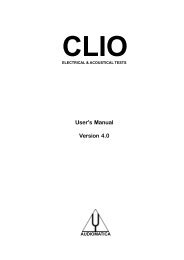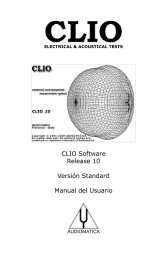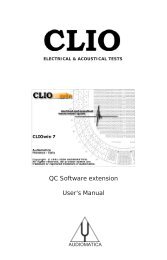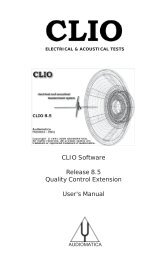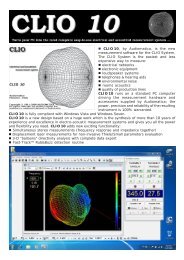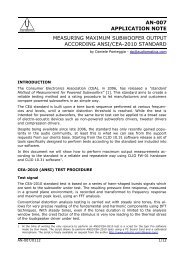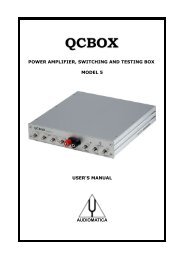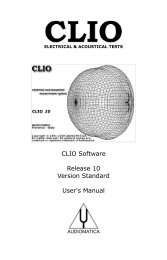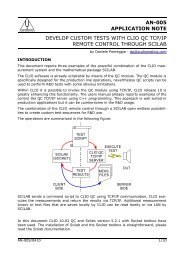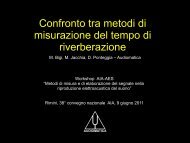CLIOwin 7 PCI User's Manual - Audiomatica
CLIOwin 7 PCI User's Manual - Audiomatica
CLIOwin 7 PCI User's Manual - Audiomatica
You also want an ePaper? Increase the reach of your titles
YUMPU automatically turns print PDFs into web optimized ePapers that Google loves.
10 MLS & LOG CHIRP<br />
10.1 INTRODUCTION<br />
Within this menu two different technique are available that yields to the final result, the<br />
complex transfer function of a generic device. They are MLS and LOG CHIRP Analysis.<br />
While the internal processing is quite different the result is the same and this justify<br />
keeping them together. Advantages of each approach will be described later in this<br />
chapter briefly, leaving to the bibliography for details.<br />
MLS stands for Maximum Length Sequences, is a powerful well established technique<br />
that allows you to carry out analysis of linear systems recovering the Impulse<br />
Response of the device using a fast cross-correlation algorithm . It is therefore a Time<br />
based analysis. Frequency domain information is obtained calculating the Fast Fourier<br />
Transform, hereafter FFT, of the impulse response.<br />
LOG CHIRP analysis uses a log-swept sine chirp as stimuli. The Frequency Response is<br />
obtained with a deconvolution process and the impulse response with an Inverse FFT<br />
of the Frequency Response<br />
Both approaches carry a crucial piece of information in the time domain, the Impulse<br />
Response. MLS & LOG CHIRP is therefore particularly well suited for recovering the<br />
anechoic sound pressure response of a loudspeaker. i.e. the frequency response of a<br />
loudspeaker as if it where positioned in an anechoic room, while carrying out the<br />
measurement in a normal room. Just as importantly MLS & LOG CHIRP allows complete<br />
evaluation of room acoustic parameters.<br />
Within this Menu the user will be able to switch from time domain to frequency domain<br />
and back using the powerful post processing tools CLIO provides. This allows the<br />
collection of very sophisticated and complete information of any electro-acoustic<br />
device. Both the theory behind all of this and the amount of parameters that affect the<br />
measurement results make this Menu probably the most complicate to use. We will skip<br />
the theory completely and after a concise description of the whole User interface we<br />
will deal with real life applications.<br />
10.2 MLS & LOG CHIRP CONTROL PANEL<br />
Figure 10.1<br />
Chapter 10 - MLS 109



